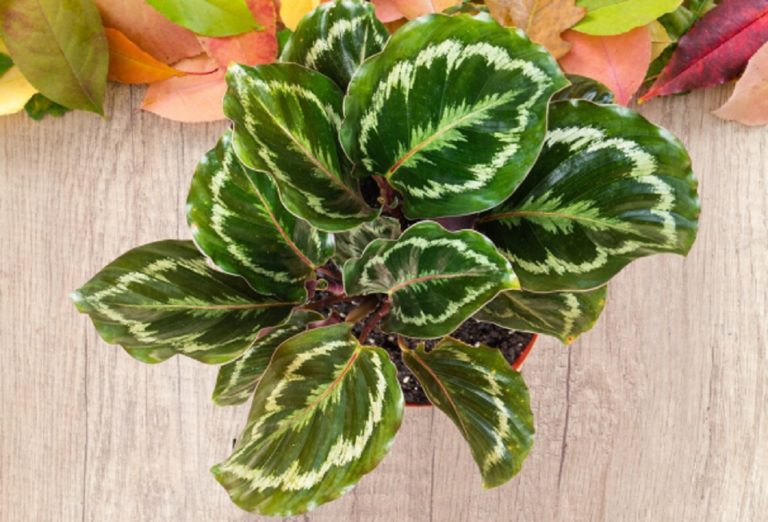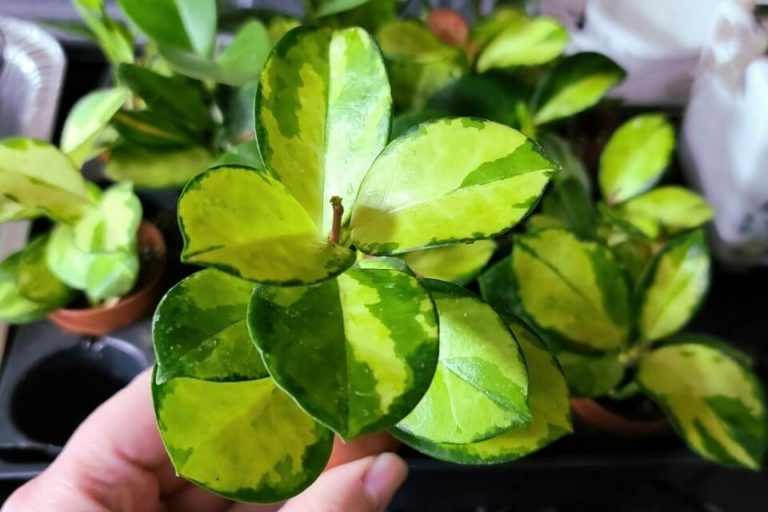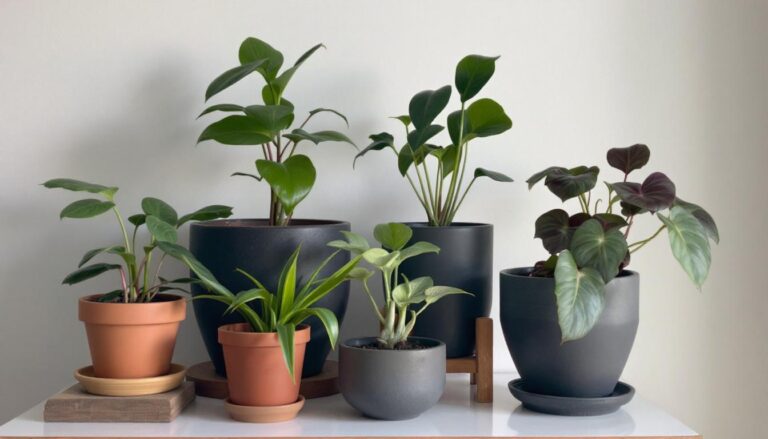Ideas to Enhance Your Home Decor with Large Indoor Plants
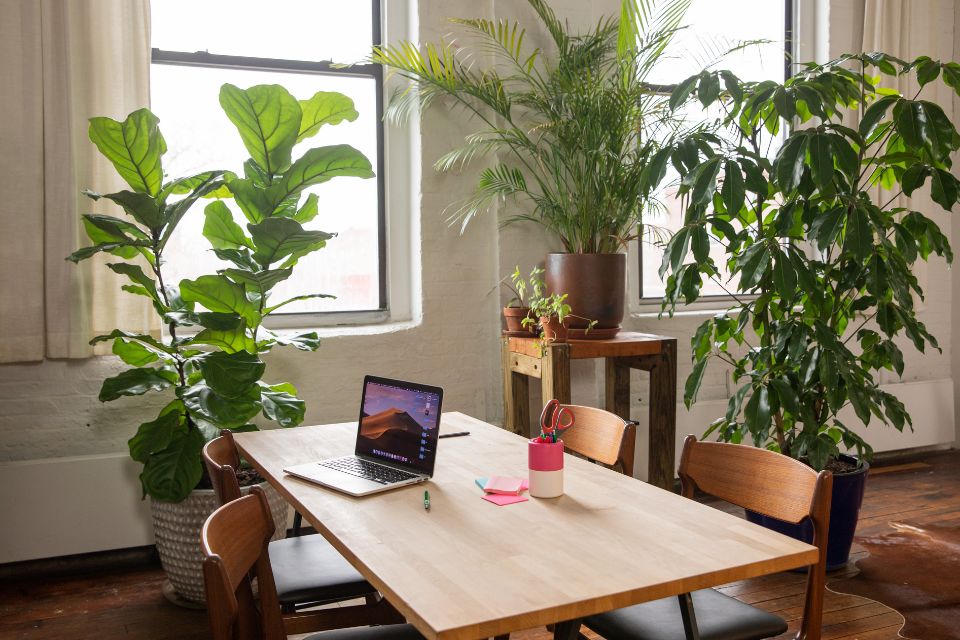
When it comes to Home Decor, there are a lot of different options to choose from. You can go with traditional furniture and accessories, or you can try something a little more daring and unique.
If you’re looking for something that will really make your home stand out, consider using Large Indoor Plants to enhance the look and feel of your decor.
Not only are they a beautiful addition, but they also have many practical benefits such as improving air quality and helping to reduce stress levels. So if you’re looking for a way to add some life and color to your home, consider using large indoor pot plants!
TABLE OF CONTENTS
Ideas for Using Large Indoor Plants
Home decor isn’t just about choosing the right furniture and paint colors. Indoor plants can also play a big role in making your home feel inviting and stylish.
Large pots are a great way to add some greenery to your space, and they can also help to purify the air. If you’re not sure where to start, here are a few ideas for using large indoor pot plants to enhance your home decor:
– Place a Large Potted Plant in Your Entryway
The entryway to your home is the first thing guests see when they come over, so you want to make sure it gives off a good impression. One way to do this is by placing a large potted plant in the entryway.
Not only will it add a touch of greenery and life to the space, but it will also make it feel more welcoming and inviting. Guests will feel like they are being greeted by nature as soon as they step through the door.
And if you choose a plant with a pleasant scent, it will further add to the inviting atmosphere of your entryway. So next time you have guests coming over, make sure to give them a warm welcome by placing a large potted plant in your entryway.
– Create a Botanical-Inspired Display
When it comes to sprucing up your home, there are few things more satisfying than a botanical-inspired display. And what better place to show off your green thumb than on the mantel or shelf?
Using several smaller pots, you can create a beautiful and eye-catching display that is sure to impress your guests. Plus, it’s a great way to add a touch of nature to any room.
To get started, simply choose a selection of plants that you love. Then, find some small pots or containers that will allow you to showcase each plant in its own individual space.
Once you have everything assembled, take a step back and enjoy your handiwork! With a little bit of effort, you’ve created a stylish and unique display that is sure to turn heads.
– Fill an Empty Corner
When you have an empty corner in your home, it can be tricky to know how to fill it. One option is to go big and make a dramatic statement by filling the space with a floor-to-ceiling tree.
This will create a focal point in the room and can help to break up large expanses of a blank wall. If you choose an evergreen tree, it will also provide some year-round greenery.
When placing your tree, make sure that it is near a window so that it can get plenty of natural light. You will also need to water it regularly and provide any other care that is necessary to keep it healthy.
With a little bit of effort, you can turn an empty corner into a stylish and unique space.
– Add Greenery to Your Living Room
Adding a touch of greenery to your living room is a great way to inject some life into the space. Not only do plants help to purify the air, but they can also boost your mood and improve your overall sense of well-being.
When choosing a plant for your bedroom, it’s important to select one that is suitable for low-light conditions. Some good options include snake plants, spider plants, and peace lilies.
These tough plants are relatively easy to care for, and they will thrive even if you don’t have a green thumb. Best of all, they don’t require much space, so you can easily tuck them into a corner or atop a dresser.
So if you’re looking for a simple way to refresh your bedroom, consider adding a potted plant.
The Benefits of Using Large Indoor Plants
Improvs Air Quality
One of the most important benefits of having large indoor pot plants is that they help to improve air quality. Indoor plants act as natural air purifiers, and they can remove harmful toxins from the air. This is especially beneficial if you live in an urban area where air pollution is a problem. Studies have shown that indoor plants can significantly reduce levels of carbon dioxide, formaldehyde, and other volatile organic compounds. So if you’re looking for a way to create a healthier home environment, adding some large indoor pot plants is a great place to start.
Helps to Reduce Stress Levels
Another great benefit of large indoor pot plants is that they can help to reduce stress levels. This is because plants have a calming effect on the nervous system. Studies have shown that looking at plants can lower blood pressure and heart rate, and it can also help to reduce anxiety and fatigue. So if you’re looking for a way to create a more relaxing home environment, adding some large indoor pot plants is a great option.
Adds Life and Color to Your Home
In addition to their practical benefits, large indoor pot plants also add life and color to your home. They can brighten up any room, and they add a touch of nature to your indoor space. If you’re looking for a way to enhance your home decor, adding some large indoor pot plants is a great option.
Best Placements of Large Indoor Plants
Large indoor plants are a popular way to add a touch of nature to your home. They can help to purify the air and create a feeling of calm, and they can also be an attractive addition to your décor.
When choosing a spot for your large indoor pot plant, there are a few things to keep in mind.
First, make sure that the plant has enough light. Most large indoor plants need at least four hours of direct sunlight each day, so choose a spot near a window or door where they can get some sun.
Second, consider the temperature of the room. Some plants do not like to be in too much heat or too much cold, so check the plant’s care requirements before placing it in your home.
Finally, think about the traffic flow in the room. You don’t want your plant to be in the way, so choose a spot where it can sit without being disturbed. With these tips in mind, you’ll be sure to find the perfect spot for your large indoor pot plant.
Tips For Choosing a Best Indoor Plant
When it comes to choosing the best indoor plant for your home, there are a few factors to consider. First, think about the amount of natural light in your space.
If you have a room with lots of windows and bright sunlight, Succulents and Cactus are low-maintenance options that will thrive. For rooms with lower lighting levels, opt for plants like ferns or spider plants that don’t require as much light to grow.
Next, consider the size of your space and the amount of room you have for a plant. If you have a large empty corner, a tall tree or palm planted in a statement-making pot can make a dramatic impact.
Or if you’re looking for something more compact, a tabletop plant like a snake plant or bonsai tree is a great option. Finally, think about your own personal care routine.
Some plants need to be misted or watered daily, while others can go weeks without being watered at all. Consider how often you’re willing to water a plant before making your final decision.
With these factors in mind, you’ll be sure to choose the best indoor plant for your home.
List of Best Indoor Pot Plants to Choose From
As we mentioned above there are many indoor plants to choose from, but here are some of our favorites:
1. Rubber Plant (Ficus elastica)

Ficus elastica is a large indoor plant that is native to South Asia. It is also known as the rubber plant or the Indian rubber tree. The plant has large, glossy leaves and a thick, upright trunk.
It can grow up to 15 to 20 feet tall and is often used as a houseplant or in commercial settings such as offices and malls. Ficus elastica is easy to care for and does not require frequent watering.
However, the plant does prefer bright, indirect sunlight and should be protected from drafts. With proper care, Ficus elastica can make an excellent addition to any home or office.
2. Ficus Alii Plant
The Ficus Alii Plant is a large indoor plant that can grow up to 8 feet tall. It has large, dark green leaves that are 2 to 3 inches long and 1 to 2 inches wide.
The Ficus Alii Plant is native to Southeast Asia and is widely cultivated in the United States. It prefers warm, humid climates and does best in bright, indirect sunlight.
The Ficus Alii Plant is an easy plant to care for and is a good choice for beginners. It is tolerant of low light levels and can even survive brief periods of drought.
When caring for a Ficus Alii Plant, be sure to water it regularly and fertilize it every few weeks. With proper care, the Ficus Alii Plant will thrive and make a beautiful addition to any home.
3. Dracaena Fragrant Plant (Corn Plant)
The Dracaena Fragrans plant, more commonly known as the corn plant, is a popular indoor pot plant. Originally from Africa, the corn plant is tough and adaptable, able to withstand a wide range of environmental conditions.
However, it is also an attractive plant, with long, arching leaves that are often variegated with green and yellow stripes. corn plants are easy to care for, making them ideal for busy households or beginners.
They prefer bright, indirect light but will also tolerate low light levels. corn Plants should be watered every week or two, allowing the soil to dry out slightly between waterings.
With proper care, corn plants can reach heights of up to 6 feet. As a result, they make a stunning addition to any home or office.
4. Swiss Cheese Plant
The Swiss Cheese Plant, otherwise known as the Monstera Deliciosa, is a popular indoor pot plant. Native to tropical regions of Mexico, Central America, and the Caribbean.
The Swiss Cheese Plant is characterized by its large, glossy leaves with distinctive holes. The plant is relatively easy to care for, and it prefers bright, indirect light.
Swiss Cheese Plants are also known for being strong air purifiers, capable of removing harmful toxins from the air. As a result, they make an excellent addition to any indoor space.
If you’re looking for a low-maintenance plant that can improve the air quality in your home, the Swiss Cheese Plant is a great choice.
5. Weeping Fig Plant
The Weeping Fig Plant is a popular indoor pot plant. It is loved for its elegant, pendulous branches and glossy, dark green leaves. The Weeping Fig is easy to care for and makes a beautiful addition to any home or office.
Native to Southeast Asia, the Weeping Fig prefers warm, humid climates. However, it can adapt to a wide range of indoor environments. When choosing a location for your Weeping Fig, make sure to choose an area with bright, indirect light.
Too much direct sunlight can scorch the leaves. The Weeping Fig also prefers high humidity levels, so it is a good idea to mist the leaves regularly or place the pot on a pebble tray filled with water.
The Weeping Fig is not a particularly drought-tolerant plant, so make sure to water it regularly. Allow the top inch of soil to dry out between watering. If the leaves begin to droop, that is a sign that the plant needs more water.
With proper care, your Weeping Fig will thrive indoors for many years. Enjoy your beautiful indoor plant!
6. Fiddle Leaf Fig Tree
The Fiddle Leaf Fig Tree is a popular indoor pot plant that is known for its large, glossy leaves. Native to tropical regions of Africa, the Fiddle Leaf Fig is an evergreen tree that can grow up to 50 ft.
However, when grown in a pot, it typically only reaches a height of 8 to 10 ft.
The Fiddle Leaf Fig is a relatively low-maintenance plant that does not require regular pruning. It prefers bright, indirect sunlight and should be watered when the top layer of soil is dry to the touch.
With proper care, the Fiddle Leaf Fig plant can thrive indoors for many years.
7. Ficus Triangularis Plant
The Ficus Triangularis, also known as the Triangle Fig or triangular fig, is an indoor pot plant that originates from Southeast Asia. It is a member of the Moraceae family, which includes plants such as the Mulberry and Banyan tree.
The Ficus Triangularis gets its name from its unique leaf shape – the leaves are three-sided with smooth edges, and they come to a point at the tip. The plant can grow up to 8 ft. in height, and it has a spreading, cascading habit.
The leaves are dark green in color with white creamy edges, and they are glossy and leathery. The Ficus Triangularis is an easy plant to care for, and it makes an excellent choice for beginners.
It prefers bright, indirect sunlight and evenly moist soil. With proper care, the Ficus Triangularis will thrive indoors for many years.
8. Madagascar Dragon Tree
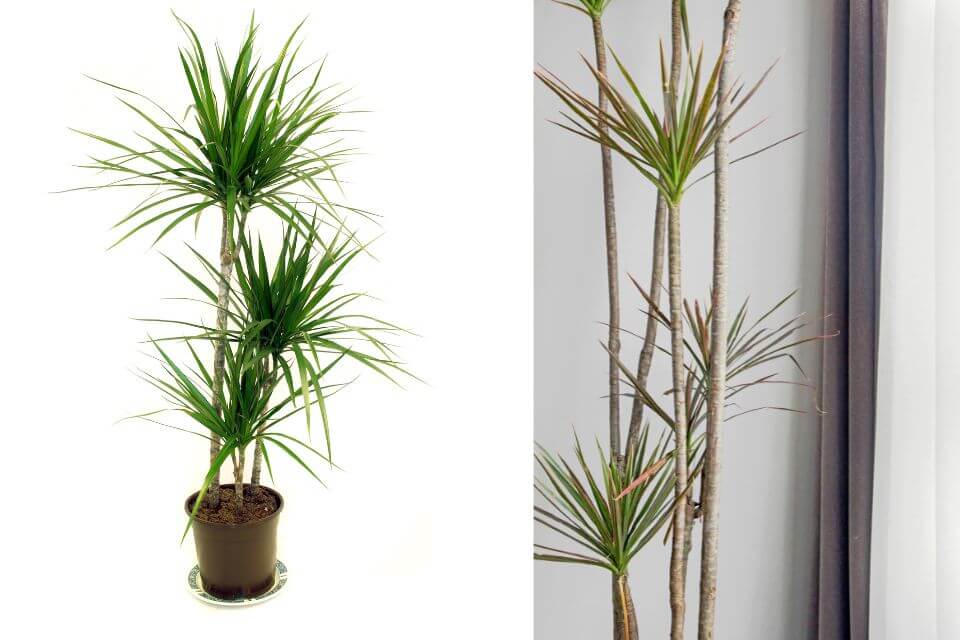
The Madagascar dragon tree (Dracaena marginata) is a popular indoor pot plant. It is easy to care for and tolerates a wide range of growing conditions.
The Madagascar dragon tree is native to the island of Madagascar, where it grows in dry, rocky habitats. The tree gets its common name from its long, slender leaves, which have sharp, serrated edges.
The leaves are usually green, but some varieties have variegated leaves with stripes of yellow or cream. The Madagascar dragon tree can grow up to 15 to 20 feet tall, but most indoor plants are kept much smaller about 4 to 7 feet.
When grown as a houseplant, the Madagascar dragon tree should be fertilized monthly during the growing season. It can be transplanted into a larger pot as needed.
If the tips of the leaves begin to turn brown, it is an indication that the plant is not getting enough water. The Madagascar dragon tree is an attractive indoor plant that is easy to care for. With proper care, it will thrive for many years.
9. Ponytail Palm Tree
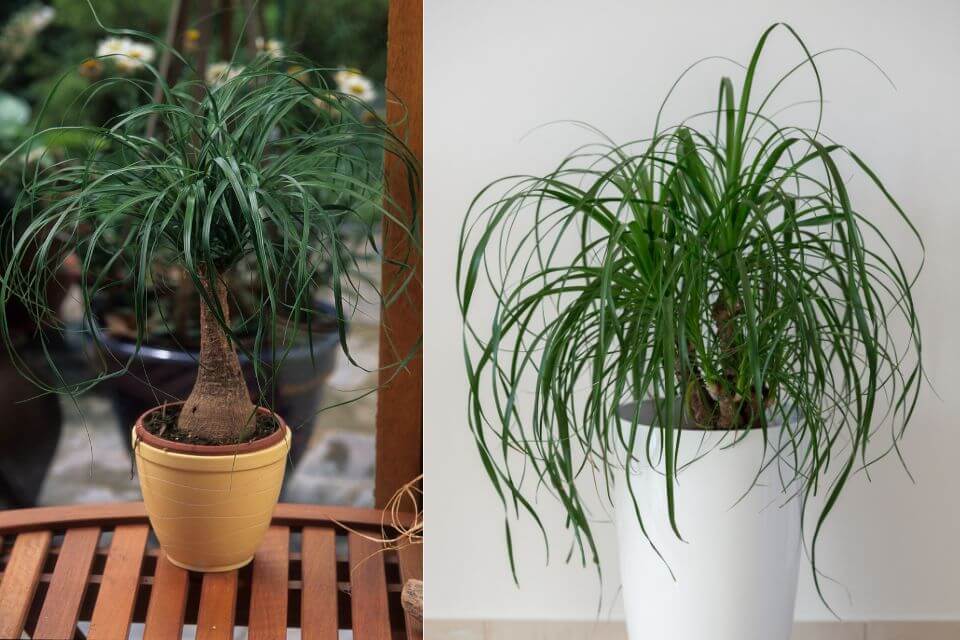
The Ponytail Palm tree (Beaucarnea recurvata) is a common indoor pot plant that is recognizable for its long, slender leaves. It is native to Mexico and Central America, and it is relatively easy to care for.
Ponytail palms prefer bright, indirect sunlight and well-draining soil. They should be allowed to dry out completely between waterings, and they should be fertilized once a month during the growing season.
Ponytail palms are slow-growing plants, but they can eventually reach heights of six feet or more. When they are young, they typically have a single stem.
However, as they mature, they produce multiple side shoots that give the plant a fuller appearance. Thanks to their hardy nature and attractive foliage, ponytail palms make excellent houseplants for both beginners and experienced gardeners alike.
10. Philodendron Selloum
The Philodendron selloum plant is a popular indoor pot plant, known for its large, leathery leaves. The plant is native to tropical climates, especially in Paraguay, Brazil, Bolivia, and Argentina where it grows as an evergreen shrub.
In its natural habitat, the Philodendron selloum can reach heights of up to 10 feet. However, when grown in a pot, the plant typically only reaches 3 to 6 feet in height.
The Philodendron selloum is easy to care for and doesn’t require much attention. It prefers indirect sunlight and needs to be watered about once a week. The plant is also fairly tolerant of poor soil conditions.
However, if the leaves start to turn yellow, it’s a sign that the plant is not getting enough nutrients. Overall, the Philodendron selloum is a low-maintenance plant that makes a great addition to any indoor space.
Take Away
In conclusion, large indoor pot plants can enhance the look and feel of your home decor. They are a beautiful addition that can also improve air quality and help reduce stress levels.
All of the plants listed above are excellent choices for indoor pot plants. They are easy to care for, and they come in a variety of sizes and shapes. Indoor pot plants can brighten up any room and add a touch of nature to your home.
If you’re looking for some new ways to enhance your home decor, consider adding one or more of these beautiful plants to your indoor space.



